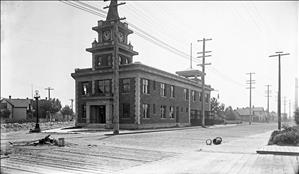The independent city of Georgetown, which included the first Euro-American settlements in King County and was incorporated in 1904, votes on March 29, 1910, to join its giant neighbor to the north. The area east of the mouth of Duwamish River was first settled in 1851 and later became the world's sixth largest brewer of beer. Despite a population of 4,000 and strong commercial base, the struggling municipality could not afford to underwrite basic public services.
Pioneer Settlers
Pioneer farmers Luther Collins (1813-1860), Henry Van Asselt (1817-1902), and Jacob Maple (or Mapel) (1798-1884), and his adult son Samuel Maple (or Mapel) (1827-1880) arrived in the area on September 14 and selected King County's first Donation Claims to the east bank of the mouth of the Duwamish River on September 16, 1851.
Entrepreneur John Pinnell established the region's first race track in the Georgetown area in 1869. His "vice" was partially balanced by the Sisters of Providence when they took over management of the County Poor Farm in 1877. The scales tipped again in 1883 with construction of the first of three major breweries in the neighborhood. Not coincidentally, German immigrants made up much of the local population, which reached 4,000 by 1910.
Developer Julius Horton, brother of pioneer Seattle banker Dexter Horton (1825-1904), purchased the Collins homestead in 1871. He incorporated his holdings in 1890 and named the new city for his son George. Seattle was linked to Georgetown by the area's first interurban railway in 1893. Voters decided to incorporate Georgetown as a third-class city on January 8, 1904. In 1906 a large steamplant was constructed to provide power to trolleys and other customers.
Facing the Inevitable
By 1910, Georgetown was flanked on three sides by the expansion of Seattle. The rich delta bottomland that had attracted the original farmers was being drained and filled to create Harbor Island, rail yards, industrial districts, and the future Boeing Field (now part of the City of Tukwila). Seattle completed the annexation just in time for it to be included in the 1910 U.S. Census. Recognizing that resistance was futile, Georgetown citizens voted to be assimilated by Seattle. Some modern Georgetown residents retain a spirit of defiant if quirky independence, exemplified by the movement to preserve the funky Hat & Boots gas station on 6800 E Marginal Way. Other surviving landmarks include the Steam Plant Museum and former Seattle Brewing & Malting Co. building at 6000 Airport Way S.

